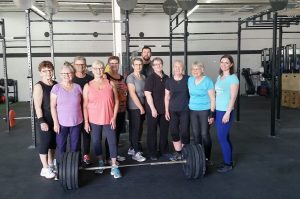In Love with Longevity
Teresa Waser, MScPT, BSc, CAFCI, CFL1 Trainer
Every Tuesday and Thursday morning at a gym in Leduc, my favourite hour begins. A group of women come together to work out. The session starts with a group warm-up, then they work on strength training – honing their technique under close supervision and building strength under the barbell. Finally, they finish it off with a WOD (“workout of the day”), typically involving some interval training. We laugh, smile and encourage each other as both a sheen of sweat and a sense of accomplishment appear. These are my Longevity ladies and let me tell you, they are amazing.
Longevity began in the fall of 2016, with the realization that there was a need in the community for safe, appropriate and effective exercise programming for older adults. In the clinic, I saw that a lot of my older patients were having difficulty maintaining their strength and function as the years went on. Conditions such as osteoarthritis and osteoporosis often left them feeling as if their bodies were no longer their own – afraid to get active, unsure of what to do and, as a result, becoming or remaining more sedentary. Unfortunately, this only exacerbates the decline. We hurt, so we move less. And when we move less, we get weaker which makes it harder to move and then we get more pain. Bones deteriorate, balance suffers and falls occur. Sadly, this is often just chalked up to “aging”, as if there is nothing we can do. Fortunately, that is far from the truth.
Recent research, including the ground-breaking work performed by The Bone Clinic in Australia, has demonstrated that strength training is both safe and extremely effective in older adults, including osteoporotic patients. They have demonstrated that bone responds best to progressive strength training. Although walking, swimming and aquacize are all wonderful activities, they do not provide the stimulus needed to adequately improve bone mineral density. Additionally, they pale in comparison to the strength gains that can be achieved in the older adult with appropriate, supervised strength training.
But there is more to it than getting stronger and building denser bones. We all want that, but what really makes me happy is when I hear my patient say she can now play with her grandkids because getting on and off of the floor isn’t so hard anymore, she can now pick up her grandchild, go up the stairs much more easily, and so on. I see my Longevity ladies and I see the decline in their function is not only slowed down, but reversed. They are getting stronger, fitter, moving better and they are having so much fun doing it. We have a number of participants in their 70s, some with joint replacements, many with osteoarthritis and osteoporosis, and they are all making gains.
The body does not stop listening to us as we get older, we tend to stop talking. Whatever your starting point, today can be the beginning. Let’s start the conversation.
Longevity is a registered program held out of CrossFit Leduc for adults over the age of 50. The program is led by Physiotherapist, Teresa Waser and CrossFit Leduc Coach/Owner, Brad Bendfeld. Teresa also provides physiotherapy and personal training at her new clinic, RX Physiotherapy. More information can be found at rxphysiotherapy.com and crossfitleduc.com.



